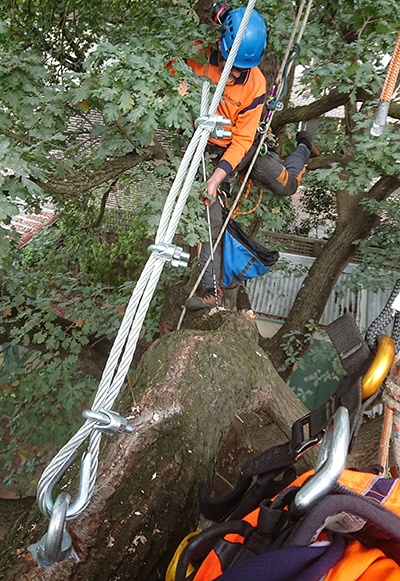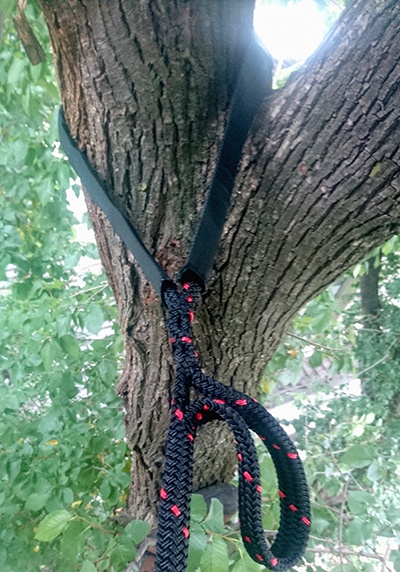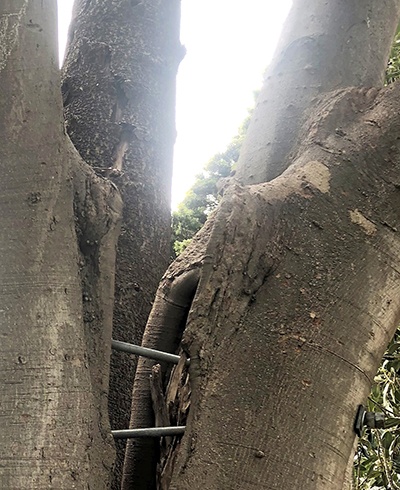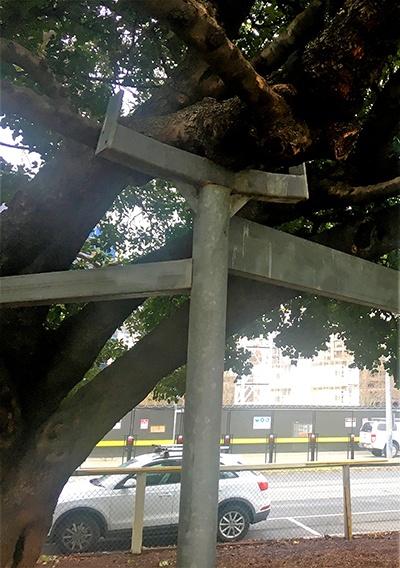Support systems can be an integral competent of tree care where the preservation of weakened or structurally compromised trees is desired. These risk mitigation options provide supplemental physical support for weak branches and stems; however, it is important to understand that not all risk can be mitigated by installation of a tree support system.
Sometimes pruning alone or pruning in combination with a support system can be sufficient to mitigate the identified problem. Not all weakened, or structurally defective trees however are suitable for pruning or the installation of support systems and removal may need to be considered.
 Steel (static) Cables: High strength steel cable are secured to anchors inserted through branches. They are intended to restrict the distance that branches can move in relation to each other reducing the risk of branch failure and when properly designed should be sufficiently strong to support a failed branch.
Steel (static) Cables: High strength steel cable are secured to anchors inserted through branches. They are intended to restrict the distance that branches can move in relation to each other reducing the risk of branch failure and when properly designed should be sufficiently strong to support a failed branch.
 Soft (dynamic) Cables: An alternative to steel cabling is synthetic fibre cable. They are non-invasive devices attached externally to the tree that provide a dynamic support system, allowing secured stems / branches to move more freely than steel cables whilst reducing the potential for shock loading when if two stems / branches move in opposite directions with great force.
Soft (dynamic) Cables: An alternative to steel cabling is synthetic fibre cable. They are non-invasive devices attached externally to the tree that provide a dynamic support system, allowing secured stems / branches to move more freely than steel cables whilst reducing the potential for shock loading when if two stems / branches move in opposite directions with great force.
 Braces: Threaded metal rods are installed through the unions of weak branches and stems intended fastening the to provide rigid support from twisting forces and tension forces that may otherwise cause these unions to fail. They are also used to fasten together a branch or stem union that is split or cracked and usually are accompanied by at least one cable.
Braces: Threaded metal rods are installed through the unions of weak branches and stems intended fastening the to provide rigid support from twisting forces and tension forces that may otherwise cause these unions to fail. They are also used to fasten together a branch or stem union that is split or cracked and usually are accompanied by at least one cable.
 Props: Ground anchored rigid support structures, designed and engineered for individual circumstances and intended to provide actin in compression to support branches that are elongated, poorly tapered and heavy end weighted and cannot be naturally supported or trees that has poor root anchorage.
Props: Ground anchored rigid support structures, designed and engineered for individual circumstances and intended to provide actin in compression to support branches that are elongated, poorly tapered and heavy end weighted and cannot be naturally supported or trees that has poor root anchorage.
Support systems should only ever be installed based on a thorough examination of the tree by a qualified arborist to determine the suitability and specify the type of support appropriate for your tree.
It is important to understand that all support systems have a limited service life that will vary depending on the material used and the local climate and tree growth rate. Support systems require regular inspection to check for system integrity and determine when replacement is required.




